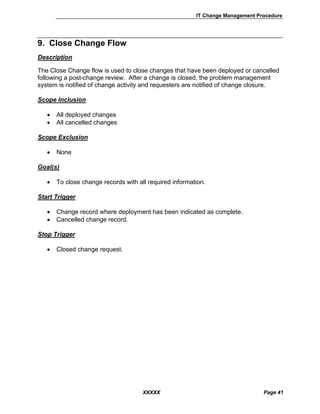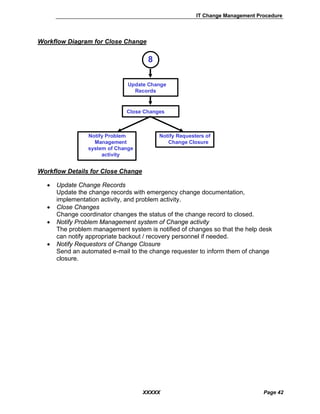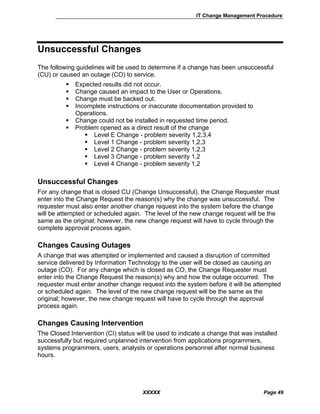This document outlines the change management process and procedures for XXXXX Information Technology. It defines change levels from Level 1 to Level 4 based on impact and risk, with Level 1 being minor changes and Level 4 being major changes. It describes the approval, lead time, and documentation requirements for each level. It also outlines the roles and responsibilities in the change management process and the workflows to enter, approve, implement, and close a change request.























![IT Change Management Procedure
XXXXX Page 24
Workflow Diagram for Enter Change Request
Workflow Details for Enter Change Request
• Document and Submit Change Request
Collect system change request and begin preliminary review of the change.
• Valid Request?
Notify Requester Change
Request received –
email [Open CR]
Notify Requester Change
Request rejected –
phone call or e-mail
Assign request
to IT analyst
Conduct Technical
Assessment
Valid
Request?
Valid
Request?
Close Change
Yes
Yes
No
No
22
Complete Change Record
to Request Level
Establish Initial Impact
Document and Submit
Change Request](https://image.slidesharecdn.com/sampleprocessguide-changemanagement-170317100526/85/Sample-process-guide_-_change_management-24-320.jpg)
![IT Change Management Procedure
XXXXX Page 25
Determine whether or not to submit change request into change management
system based on whether the request form has a managers signature, it is within
IT responsibility, and filled in correctly.
• Notify Requester Change Request rejected – phone call or e-mail
If change request is rejected, provide a form of notification.
• Notify Requester Change Request received – email [Open CR]
If change request is approved for the change management system, a change
record is opened and a change number is assigned. A notification is auto-sent to
the change requester by Peregrine.
• Assign request to IT analyst
Assign the change request to an initial analyst to review the change record.
• Establish Initial Impact
Determine impact of the change to the customer community. This will include
times when service is not available, testing time, new procedures, new support
requirements, and any other impact that may occur as a result of the change.
• Conduct Technical Assessment
Determine the feasibility of the change from a technical perspective. This
assessment will include the amount of resources, level of knowledge, and skills
necessary for the change.
• Complete Change Record to Request Level
Based on initial impact and technical assessment, determine the type and
category level of change, and complete all descriptive fields. Additionally, the
completeness of the change success criteria is validated.
• Valid Request?
Based on the initial assessments, determine whether to perform this change.
This decision is based on the change conforming to the strategy, resources being
available, and whether or not it is already being worked on.
• Close Change
Mark change record as closed when it doesn’t pass validation requirements.](https://image.slidesharecdn.com/sampleprocessguide-changemanagement-170317100526/85/Sample-process-guide_-_change_management-25-320.jpg)


















![IT Change Management Procedure
XXXXX Page 44
• DATE IMPLEMENTED - The date that the change was implemented or tried to be implemented
(MM/DD/YY).
• TIME IMPLEMENTED - The start time of the implementation (HH:MM).
• CHANGE IMPLEMENTED BY - The person who performed the implementation.
• CHANGE ACCEPTED BY – The person accepting the change on behalf of the change requester.
• DATE CHANGE RECORD CLOSED – The date that the Change Request was closed in the
Change Management system and the person closing the change request.
The {blue text} on the form indicates that the item appears on the XX-0028 form but not on the XXX form.
It should be added to the XX Change Record.
The (red text) on the form indicates items that are not on the XX-0028 from but are on the XXX form. The
items should be on the XX Change Record.
The black text on the form indicates that the item appears on both forms and the [bracketed text] is the
name of the item on the XX-0028 form.](https://image.slidesharecdn.com/sampleprocessguide-changemanagement-170317100526/85/Sample-process-guide_-_change_management-44-320.jpg)
![IT Change Management Procedure
XXXXX Page 45
CHANGE REQUEST FORM
DATE REQUESTED ___[Date]__________ DATE PLANNED_[Target Completion Date]_____________
PEREGRINE CHANGE NUMBER ___________ [Control
No.]___________________________________
REASON FOR CHANGE _________________[Justification for Request]__________________________
___________________________________________________________________________________
_
DESCRIPTIONS OF CHANGE __________[Nature of Request]_________________________________
___________________________________________________________________________________
_
{REQUEST CATEGORY:___LOCAL ___DISTRICT MISSION ___STATE ___FEDERAL ___OTHER}
{PROJECT CATEGORY: ____MAJOR ____MODERATE ____MINOR ____AD HOC}
{CHANGE TYPE: ADMINISTRATIVE_________ INSTRUCTIONAL________}
(RISK ASSESSMENT CATEGORY
_______________________________________________________)
(USER ACCEPTANCE CRITERIA DEFINED AND AGREED TO? YES____ NO____)
CHANGE REQUESTED BY _______[Submitted by:]__________________________________________
{LOCATION
_________________________________________________________________________}
CHANGE AUTHORIZED BY ______[Approved by:]___________________________________________
(CHANGE APPROVED
BY______________________________________________________________)
{DISPOSITION: ____APPROVED FOR IMMEDIATE WORK
____APPROVED AS PRIORITIZED
____APPROVED FOR FURTHER INVESTIGATION (Cost/Benefit, Impact Analysis)
____REQUEST REJECTED
Explanation:______________________________________________________}
{TARGET BEGIN DATE:______________}
INDIVIDUAL RESPONSIBLE FOR IMPLEMENTATION _____________[Assigned to:]_______________
(INDIVIDUAL RESPONSIBLE FOR UNIT TEST
_____________________________________________)
(INDIVIDUAL RESPONSIBLE FOR SYSTEM TEST _______________________________)
(INDIVIDUAL RESPONSIBLE FOR USER ACCEPTANCE TEST ______________________)
(TEST SCHEDULE - UNIT TEST END DATE __________________________________)
( SYSTEM TEST END DATE ________________________________)
( USER ACCEPTANCE TEST END DATE _______________________)
(COMMUNICATION PLAN ___________________________________________________)
(______________________________________________________________________)
(USER MANUALS AND OPERATING INSTRUCTIONS TO BE UPDATED_________________)
(______________________________________________________________________)
(FALLBACK / BACKOUT PROCEDURE _________________________________________)
(______________________________________________________________________)](https://image.slidesharecdn.com/sampleprocessguide-changemanagement-170317100526/85/Sample-process-guide_-_change_management-45-320.jpg)






















